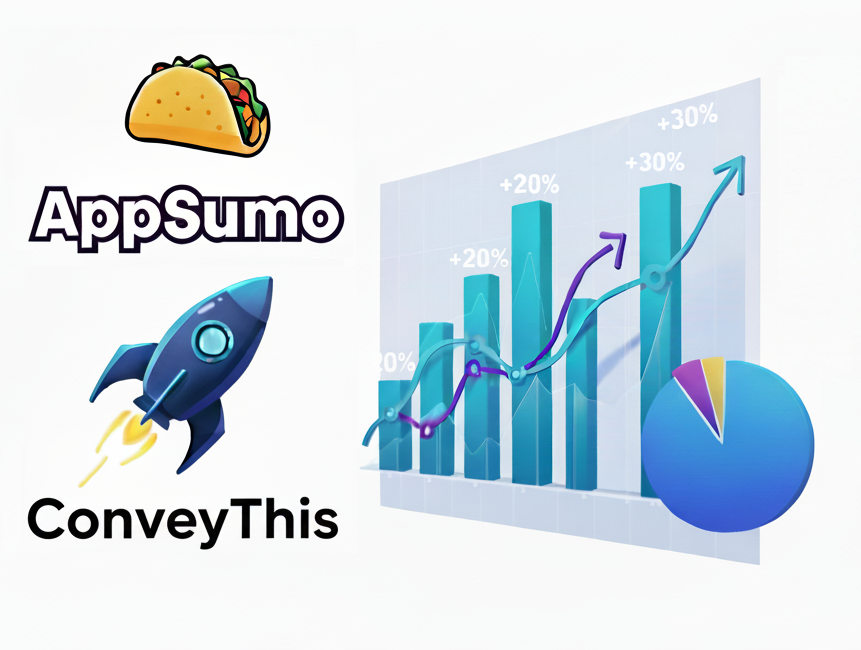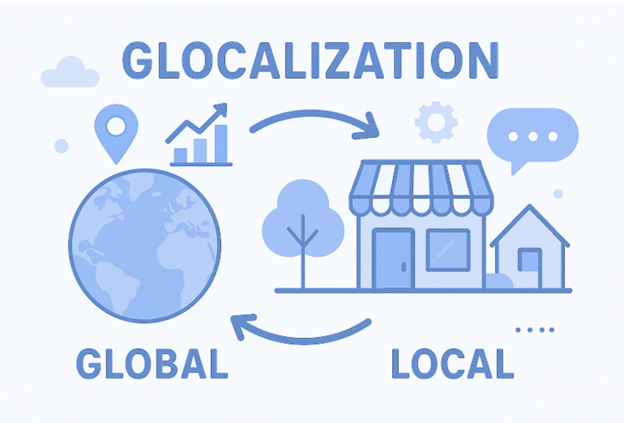ConveyThis के साथ एक प्रभावी वैश्विक विपणन रणनीति तैयार करना
एक सफल वैश्विक विपणन रणनीति तैयार करना
हमारी आधुनिक डिजिटल दुनिया में, भौगोलिक सीमाएँ व्यवसाय के विस्तार में पहले की तुलना में बहुत कम बाधा उत्पन्न करती हैं। वैश्वीकरण और अधिक खुली व्यापार नीतियों के कारण, उत्पादों और सेवाओं को अंतर्राष्ट्रीय दर्शकों तक ले जाना पहले से कहीं अधिक संभव है। हालाँकि, विदेशी ग्राहकों को प्रभावी ढंग से संलग्न करने के लिए प्रत्येक बाजार के लिए स्थानीयकृत विपणन रणनीतियों को सावधानीपूर्वक तैयार करने की आवश्यकता होती है।
यह गहन मार्गदर्शिका इस बात का पता लगाती है कि कैसे अनुकूलनीय वैश्विक विपणन योजनाएँ बनाई जा सकती हैं, साथ ही उन ब्रांडों के वास्तविक दुनिया के उदाहरण भी प्रदान किए जा सकते हैं जो इसे सही करते हैं। वैश्विक स्तर पर ग्राहकों को सफलतापूर्वक आकर्षित करने के लिए क्या करना पड़ता है, इस पर विस्तृत जानकारी के लिए आगे पढ़ें।

वैश्विक विपणन रणनीतियों को परिभाषित करना
एक वैश्विक विपणन रणनीति विशिष्ट अंतरराष्ट्रीय क्षेत्रों के लिए अनुकूलित लक्षित प्रचार रणनीतियों के साथ एक ब्रांड की व्यापक पहचान और दृष्टि को संरेखित करती है। लक्ष्य क्षेत्रीय सांस्कृतिक मूल्यों और प्राथमिकताओं के अनुरूप संदेश, पेशकश और अनुभवों को स्थानीयकृत करते हुए सभी बाजारों में एक सुसंगत ब्रांड लोकाचार प्रस्तुत करना है।
सामान्य वैश्विक विपणन ढाँचे में शामिल हैं:
- अंतर्राष्ट्रीय - स्थानीयकरण के बिना दुनिया भर में एक समान विपणन दृष्टिकोण
- बहु-घरेलू - प्रत्येक स्थानीय बाजार के लिए सिलाई रणनीति पर भारी ध्यान
- वैश्विक - स्थानीयकरण की तुलना में लागत दक्षता और मानकीकरण पर जोर
- ट्रांसनेशनल - वैश्विक स्थिरता के साथ स्थानीयकरण को संतुलित करना
रणनीतिक दृष्टिकोण के बावजूद, सांस्कृतिक बारीकियों, ग्राहक अंतर्दृष्टि और स्थानीय सर्वोत्तम प्रथाओं पर केंद्रित अनुसंधान-संचालित अनुकूलन वैश्विक विपणन सफलता के लिए महत्वपूर्ण है।
वैश्विक विपणन के दूरगामी लाभ
विश्व स्तर पर बाज़ार के लिए क्षमताएँ विकसित करने से महत्वपूर्ण लाभ मिलते हैं:
- नए विदेशी स्थानों का लाभ उठाकर ब्रांड जागरूकता और पहुंच का विस्तार किया
- सार्वभौमिक ब्रांड परिसंपत्तियों और केंद्रीकृत क्रय शक्ति के समेकन के माध्यम से विज्ञापन लागत कम की गई
- प्रत्येक बाज़ार के अनुरूप स्थानीयकृत सुधारों के माध्यम से उत्पाद की गुणवत्ता और अपील में वृद्धि
- बहुराष्ट्रीय अनुभव का लाभ उठाने और वैश्विक अंतर्दृष्टि को एकीकृत करने से प्रतिस्पर्धात्मक बढ़त
एक अच्छी तरह से तैयार की गई वैश्विक रणनीति के साथ, विपणन की भूमिका एक लागत केंद्र से एक लाभ इंजन के रूप में विकसित होती है जो वृद्धिशील अंतरराष्ट्रीय राजस्व और हिस्सेदारी को बढ़ाती है।


एक प्रभावी वैश्विक विपणन योजना के निर्माण के लिए पूर्वापेक्षाएँ
दुनिया भर में सफल मार्केटिंग शुरू करने के लिए अग्रिम जमीनी कार्य की आवश्यकता होती है:
संपूर्ण बाज़ार अनुसंधान - प्रत्येक लक्षित स्थान में उपभोक्ता के दृष्टिकोण, व्यवहार, निराशा और प्राथमिकताओं का विश्लेषण करें। सामान्यीकरण से बचें. विशिष्ट ग्राहक अंतर्दृष्टि महत्वपूर्ण हैं।
दर्द बिंदुओं को समझना - सर्वेक्षण, साक्षात्कार और डेटा विश्लेषण के माध्यम से बाजार-विशिष्ट दर्द बिंदुओं और जरूरतों को पहचानें। स्थानीयकरण को इनका उचित समाधान करना चाहिए।
बहु-क्षेत्रीय योजना - एकीकृत रणनीतियों और अभियानों का विकास करें जो सीखने के आधार पर अनुरूप क्षेत्रीय अनुकूलन के साथ बाजारों में स्थिरता को संतुलित करते हैं।
स्थानीयकरण - सांस्कृतिक मूल्यों के साथ संरेखित करने और प्रत्येक स्थानीय संदर्भ में गूंजने के लिए संदेश, रचनात्मक संपत्ति, चैनल, साझेदारी और बहुत कुछ तैयार करें। लेकिन केवल बदलाव के लिए बदलाव से बचें।
सावधानीपूर्वक तैयारी रणनीति और सामरिक सक्रियता को निर्देशित करने के लिए अंतर्दृष्टि प्रदान करती है। इस आधार पर वैश्विक विपणन योजना आकार ले सकती है।
वैश्विक विपणन योजना को जीवन में लाना
आवश्यक बुनियादी कार्य पूरा होने के साथ, विश्व-तैयार विपणन खाका व्यवहार में कैसे आता है? हालाँकि विशिष्ट दृष्टिकोण अलग-अलग होंगे, प्रभावी वैश्विक योजनाएँ अक्सर इन मूल तत्वों को प्रदर्शित करती हैं:
- एक एकीकृत ब्रांड दृष्टिकोण और विश्व स्तर पर स्थिति, कंपनी के मूल्यों के साथ संरेखित
- लोगो, नारे और दृश्य पहचान जैसी मुख्य संपत्तियों का केंद्रीकृत विकास
- डिजिटल प्लेटफॉर्म और सोशल मीडिया चैनलों पर साझा वैश्विक पहल
- वैश्विक एजेंसी संबंधों और क्रय शक्ति के माध्यम से पैमाने की अर्थव्यवस्थाएँ
- सांस्कृतिक अंतर्दृष्टि के आधार पर संदेश थीम का क्षेत्रीय वैयक्तिकरण
- स्थानीय स्वाद के अनुरूप तैयार किए गए डिजिटल अनुभव, प्रचार और साझेदारियाँ
- क्षेत्रीय सौंदर्य मानदंडों के अनुरूप भौतिक सामग्रियों, पैकेजिंग और डिस्प्ले का अनुकूलन
- अधिकतम स्थानीयकरण प्रतिध्वनि के लिए सूक्ष्म अनुवाद और ट्रांसक्रिएशन
- वैश्विक और स्थानीय ब्रांड एंबेसडर और प्रभावशाली व्यक्तियों का संतुलित उपयोग
- चल रहे स्थानीयकरण अवसरों पर जानकारी के लिए क्षेत्रीय टीमों को एकीकृत किया गया
अंतिम सूत्र मानकीकरण को अनुकूलित क्षेत्रीय सक्रियता के साथ सामंजस्यपूर्ण रूप से मिश्रित करता है - विश्व स्तर पर सोचें, स्थानीय स्तर पर कार्य करें।

वैश्विक विपणन की बाधाओं को दूर करना
महत्वपूर्ण लाभ प्रदान करने के साथ-साथ, वैश्विक विपणन में सोच-समझकर सामना करने की चुनौतियाँ भी आती हैं:
विविध दर्शकों को अपनाना - ब्रांड अखंडता को बनाए रखते हुए विभिन्न सांस्कृतिक मानदंडों के साथ संरेखित करने के लिए अभियानों का स्थानीयकरण करना एक कला और विज्ञान है। एक आकार-सभी के लिए उपयुक्त मानसिकता से बचें।
नेविगेटिंग नियम - प्रत्येक लक्षित देश में कानूनों, गोपनीयता नियमों और नैतिक मानदंडों का पालन करें। जीडीपीआर, मानवाधिकार, आदि अनुपालन सफलता को सक्षम बनाता है।
दोषरहित अनुवाद - जुड़ाव और रूपांतरण के लिए भाषा, शब्दावली और संदेश का सटीक स्थानीयकरण अपरिहार्य है। शर्मनाक गलत अनुवाद से बचें.
समन्वय प्रक्रियाएं - कई लक्षित बाजारों के साथ, जटिलता के प्रबंधन के लिए क्षेत्रों, एजेंसियों और आंतरिक टीमों में वर्कफ़्लो को सुव्यवस्थित करना अनिवार्य है।
आरओआई की निगरानी - विपणन प्रभावशीलता को मापने और प्रत्येक प्रमुख स्थान में रणनीति का मार्गदर्शन करने के लिए शुरू से ही अनुशासित विश्लेषण रखें।
सावधानीपूर्वक आयोजन से, इन बाधाओं पर काबू पाया जा सकता है। सकारात्मक पहलू उन पर काबू पाना सार्थक बनाता है।
सही ढंग से किए गए वैश्विक विपणन के उल्लेखनीय उदाहरण
विश्वव्यापी प्रचार में उत्कृष्ट प्रदर्शन करने वाले ब्रांडों को देखने से सफलता के मॉडल मिलते हैं:
डोमिनोज़ पिज़्ज़ा - मुख्य मेनू को सुसंगत रखते हुए बाज़ार के अनुसार स्थानीयकृत टॉपिंग प्रदान करता है। लचीले स्थानीयकरण को सुदृढ़ करता है।
मैकडॉनल्ड्स - मानकीकृत ब्रांडिंग के साथ बाजार-विशेष मेनू आइटम के लिए जाना जाता है। संतुलन दृष्टिकोण.
नाइके - स्थानीय प्रभावशाली साझेदारियों के माध्यम से विश्व स्तर पर एकीकृत ब्रांडिंग अभियान विकसित करता है। समन्वित वैयक्तिकरण पर पनपता है।
कोका-कोला - क्षेत्रीय गतिविधियों में स्थानीय संस्कृति के उत्सव के साथ सांता विज्ञापनों जैसी सार्वभौमिक रूप से प्रतिष्ठित संपत्तियों का मिश्रण। सार्वभौमिक फिर भी स्थानीय.
ये अग्रणी व्यवसायी वैश्विक-स्थानीय संतुलन को नेविगेट करने वाले विपणक के लिए प्रेरणा प्रदान करते हैं।


बहुभाषी डिजिटल अनुभवों की महत्वपूर्ण भूमिका
जबकि प्रिंट, आउटडोर, टीवी और अनुभवात्मक महत्वपूर्ण बने हुए हैं, डिजिटल चैनल अब अपनी पहुंच, लक्ष्यीकरण और मापन क्षमता के कारण अधिकांश वैश्विक विपणन प्रयासों के केंद्र में हैं।
डिजिटल में, अनुकूलित बहुभाषी अनुभव ग्राहक जुड़ाव की कुंजी हैं। जब वेबसाइटें अंग्रेजी-केंद्रित रहती हैं तो विभिन्न संस्कृतियों में स्थानीयकृत विपणन अप्रभावी होता है।
शुक्र है, ConveyThis जैसे आधुनिक अनुवाद समाधान, वेबसाइटों को वैश्विक दर्शकों के लिए आसानी से अनुकूलित करने की अनुमति देते हैं। कृत्रिम बुद्धिमत्ता (AI) और मानव भाषाविदों का मिश्रण, हर पृष्ठ को स्थानीयकृत पाठ, चित्र, वीडियो आदि में बड़े पैमाने पर प्रस्तुत करता है। इससे नए क्षेत्रों की खोज आसान हो जाती है।
वैश्विक विपणन सफलता के लिए विशेषज्ञ युक्तियाँ
सिद्ध परिणामों के आधार पर, सीमाओं के पार विपणन प्रभाव को अधिकतम करने के लिए यहां सिफारिशें दी गई हैं:
- नए क्षेत्रों में सक्रिय होने से पहले स्थानीय संस्कृतियों और ग्राहकों में डूब जाएं। धारणाओं से बचें.
- पहलों और परिसंपत्तियों को उनके बाज़ार के अनुरूप ढालने के लिए ज़मीनी स्तर पर स्थानीय साझेदारों से परामर्श लें।
- सुनिश्चित करें कि लोगो जैसे ब्रांड पहचान तत्व सार्वभौमिक डिजाइन के माध्यम से सांस्कृतिक संदर्भों से परे हों।
- पूर्ण स्थानीयकरण निवेश से पहले, अंग्रेजी भाषा के डिजिटल अभियानों के साथ मांग का परीक्षण करें।
- दुनिया भर में विकास के अवसरों की पहचान करने के लिए लगातार ऑनलाइन व्यवहार और विश्लेषण को मापें।
सही स्थानीय मानसिकता के साथ, कोई भी ब्रांड घरेलू खिलाड़ी से वैश्विक पावरहाउस में परिवर्तित हो सकता है।
वैश्विक विपणन का विकसित होता भविष्य
हालाँकि वैश्विक विपणन के महत्व में कमी के कोई संकेत नहीं दिख रहे हैं, लेकिन आने वाले दशक में इसका स्वरूप विकसित होता रहेगा:
- जैसे-जैसे स्थानीयकरण और अनुवाद अधिक परिष्कृत होते जाएंगे, ट्रांसक्रिएशन बढ़ता जाएगा।
- वैयक्तिकरण और अनुकूलन अंतर-क्षेत्रीय ग्राहक डेटा और इंटेलिजेंस के माध्यम से प्रोग्रामेटिक रूप से तेजी से होगा।
- जैसे-जैसे वैश्विक स्तर पर ईकॉमर्स और इंटरनेट की पहुंच बढ़ेगी, डिजिटल अनुभव प्राथमिक ब्रांड टचप्वाइंट बन जाएगा।
- मोबाइल-फर्स्ट दृष्टिकोण हावी रहेगा, क्योंकि अधिकांश उभरते बाजारों में स्मार्टफोन प्राथमिक डिजिटल उपकरण बना हुआ है।
- दूरस्थ सहयोग प्रौद्योगिकी में सुधार होने पर क्षेत्रीय भागीदार नेटवर्क सक्रियण केंद्रों का विकेंद्रीकरण करेंगे।
- एट्रिब्यूशन मॉडलिंग और मल्टी-टच एनालिटिक्स वैश्विक प्रयासों को स्थानीय बिक्री प्रभाव से बेहतर ढंग से जोड़ेंगे।
समझदार विपणक दुनिया भर में प्रतिस्पर्धात्मक लाभ बनाए रखने के लिए इन रुझानों को अपनी रणनीतियों और प्रक्रियाओं में एकीकृत करेंगे।
विश्व स्तर पर विपणन के लिए जनादेश
विभिन्न उद्योगों में सभी आकार के व्यवसायों के लिए, एकीकृत वैश्विक विपणन क्षमताओं का विकास करना अब वैकल्पिक नहीं है - यह विकास के लिए एक अनिवार्यता है। दुनिया का वैश्वीकरण जारी है, और हर जगह ग्राहक अनुरूप स्थानीय अनुभवों की मांग करते हैं।
इस गाइड में उल्लिखित रणनीतियों, अंतर्दृष्टि और समाधानों के साथ, ब्रांड इस जनादेश को पूरा करने के लिए आगे बढ़ सकते हैं। जबकि वैश्विक विपणन जटिलता लाता है, प्रभावी ढंग से किया जाता है, यह अभूतपूर्व क्षितिज खोलकर बड़े पुरस्कार उत्पन्न करता है। अब समय आ गया है कि विपणक स्थानीय स्तर पर दुनिया भर में सक्रिय होकर बड़ा सोचें।
यदि आपको आज की परस्पर जुड़ी दुनिया में विश्व स्तर पर सफलतापूर्वक विपणन के इस व्यापक अवलोकन के आधार पर किसी स्पष्टीकरण की आवश्यकता है या अतिरिक्त प्रश्न हैं तो मुझे बताएं। मुझे कोई अन्य विवरण प्रदान करने में खुशी होगी जो सहायक होगा।

अनुवाद, केवल भाषाएँ जानने से कहीं अधिक, एक जटिल प्रक्रिया है।
हमारे सुझावों का पालन करके और ConveyThis का उपयोग करके, आपके अनुवादित पृष्ठ आपके दर्शकों के साथ प्रतिध्वनित होंगे, और उन्हें लक्ष्य भाषा का मूल निवासी महसूस होगा।
हालाँकि इसमें मेहनत लगती है, लेकिन परिणाम सुखद होता है। अगर आप किसी वेबसाइट का अनुवाद कर रहे हैं, तो ConveyThis स्वचालित मशीन अनुवाद के ज़रिए आपके घंटों बचा सकता है।
ConveyThis को 3 दिनों के लिए निःशुल्क आज़माएँ!
 कोई कार्ड विवरण नहीं
कोई कार्ड विवरण नहीं



